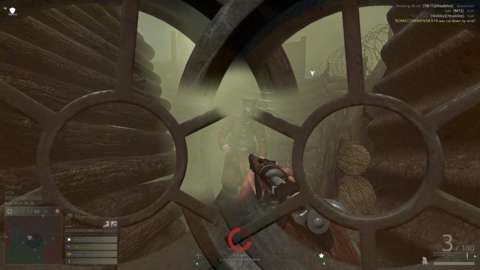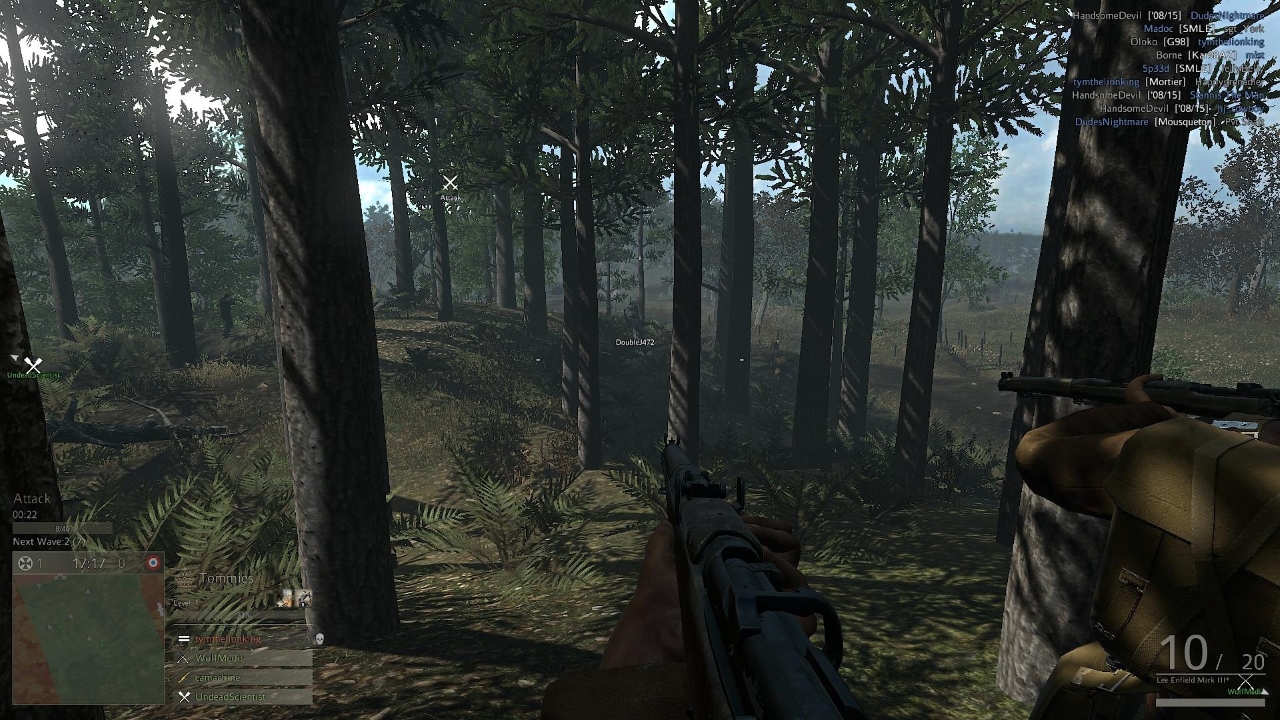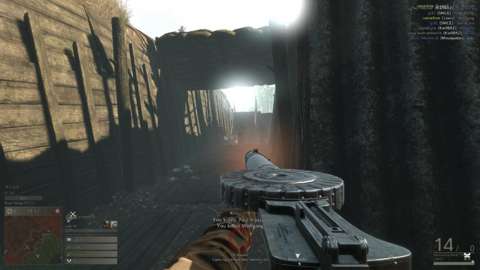The Battle of Verdun began in February 1916, and lasted ten months. It was the lengthiest battle during World War I, claiming around 700,000 dead, wounded, or missing soldiers. The multiplayer first-person shooter Verdun revisits this tragic time, bringing to life the fear and thrill, as well as the boredom, of trench warfare. Verdun takes a risk; it is a rare shooter set in a time period more frequently visited by strategy games. It gets close to capturing the essence of battle, despite being stymied by the realities of the often slow pace of the Great War, and all the while stumbling on its own obstacles.
Most of your time in Verdun is spent in its Frontlines mode. Here, two teams take turns crossing no man's land in an attempt to take their opponents' trench. It's a game of momentum. When you're on the offensive, the game allows you to charge onto the battlefield as your opponents line up in defense. Taking an enemy trench requires that you survive long enough to reach and occupy it, driving out combatants. Like in Battlefield, the more allies you have, the faster the trench is taken, and the faster you gain a point. But taking the trench won't be easy. Enemies have the advantage when you're on offense, and if your team is kept away until the end of a timer, momentum transfers to the opposing team, and soon it's their turn to charge, putting you on defense. The more you capture, the deeper the battle moves in the map toward enemy headquarters--the final goal of Frontlines. Battles switch constantly from offense to defense throughout the match, and winning outright doesn't come easy. Of all the games I played, nearly half ended in a draw. There is also a rifles-only team Deathmatch mode to consider, but the population of competing players is considerably lower than Frontlines'.
Keeping you in the World War I tug-of-war fantasy, the game introduces a "dead zone" that surrounds each of the enormous maps, and keeps you out of the field between trench lines during defense. If your team fails to capture an enemy trench, you're given a countdown timer and forced to retreat to your own line; otherwise, you are executed. You're not allowed to put even one toe past these lines, even if they lie mere inches in front of your own trench. Stepping over causes the colors to fade, and a countdown emerges, pulling you from the experience with the subtlety of a cracking whip. It can get frustrating to deal with, as you're sometimes unable to gain a better viewing angle without your own soldier barking a line about deserters getting shot the moment you move too far. It's especially irritating when you pass over the line while moving through dug-out trenches or clearly defined pathways on the battlefield.
Frontlines mode focuses on squad-based combat. Loading into a match, you get placed into a squad and fill a specific role. Some squads focus on recon, while others are attack squads that include positions for riflemen and grenadiers. Depending on the squad type, the squad leader--a non-commissioned officer, or NCO--can call in special commands such as artillery support, airplane recon, or gas assaults. Playing in a squad is highly encouraged--not only is it just short of impossible to take out a trench on your own, but it makes the game a lot more engaging. I struggled during the first several hours, grumbling every time I got killed off in some ditch or another, but Verdun opened up once I learned how to work with my squad. Communicating when and where to attack made the charging offense not only more realistic, but also made it feel like a managed, well-oiled machine. Over time, your squad levels up, unlocking bonuses such as new uniforms and status buffs. Collecting experience points happens naturally as you play, but you gain a lot more by playing with a squad. It's a much faster way to earn levels and career points, the latter of which allows you to open up new weapon tiers for your chosen class. Over time, you gain access to new and more powerful rifles, pistols, and mounted machine guns.

There is one reality of the Great War that Verdun can't escape: tedium. There are moments of boredom while desperately waiting for something to get you out of the trench. It can be a pervasive burden that may cause you, as it did me, to sprint from one end of the trench to the other in the hope that action eventually presents itself. The feeling is magnified by the respawn times, which can force you to cool your heels for twenty seconds at a time or longer--and respawning doesn't always play into your favor. There were many instances where I returned to the battlefield with a relieved sigh, only for a vigilant sniper to send me immediately back to the death screen with another twenty-plus-second wait. When most games run from fifteen to thirty minutes, expect a lot of dead air between the chaos of charges and sweeping out enemy trenches.
A lack of variety is another hindrance. Many of the maps are expectedly ugly, pockmarked with craters and devoid of much vegetation. Some fronts, however, are lusher than others, introducing trees to stack up against, along with swaying grass and bushes that add a welcome palette of color. But for the most part, the differing shades of brown with the intermittent splash of green is not a blessing to the eyes. And yes, of course I realize the battlefields of World War I were never attractive, but the aesthetic gets tiring. Beyond the art, Frontlines mode itself rarely deviates from its design, which begins to drag after many hours.

However, Verdun does deliver rare moments of inspiration when bursts of excitement and terror shatter the monotony. A bullet fired from an unseen enemy rips through the air, striking a fellow soldier just to your side. In your peripheral vision you see him collapse limply into the mud. You drop down and your mind races. Will you move locations and pop back up to scan the horizon for the killer? Are you meant to avenge your lost comrade, or join him? Back inside the trench, there is often barely enough room for two soldiers to pass by, sometimes resulting in both getting momentarily stuck as they attempt to move to another section in need of defense, all while bullets fly inches overhead, and more bodies drop. It can be scary and terribly claustrophobic at times. When enemy commanders drop choking clouds of poisonous gas upon the trench, you're forced to put on a mask that obscures most of your vision, which is already hampered by the billowing yellow cloud. Coupled with the cracks of nearby rifles you're no longer certain are friendly, that feeling of claustrophobia rapidly crumbles away to panic.
Suddenly you hear the command to charge and overrun enemy fortifications, and you leap over the edge and into the heart of no man's land. You traverse the war-torn earth by hiding behind hills, trees, or in bombed-out craters. You watch as enemies scramble over hills in a desperate attempt to reach the security of their own trench--most getting cut down before earning that safety. Crouching or lying prone helps you avoid getting taken out by enemy combatants, as you wait for a CPO to call in mortars or gas to soften the hardened enemy defense. You methodically move from one point to the next, taking time to line up your rifle and pick off enemy soldiers who carelessly expose their heads. Without question, the pace is slow and deliberate; Verdun is the antithesis of many modern shooters, yet more exciting than many of its peers for brief periods.

But even when the game is at its finest, you must still grapple with some problems. There is frequent lag, causing enemy soldiers to abandon their running animations to teleport across the field. Worse, however, are the times when your gun appears to fire through an enemy without doing any damage. This scenario happens all too often: You line up your shot, fire, and… nothing happens. You line up again, more carefully this time, fire… nothing. I have lost fights at point-blank range due to this "phantom bullet" occurrence. It seems impossible to finish more than two games without it happening, and when you drop into a twenty-second respawn after being killed by someone you know you couldn't have missed, it becomes infuriating. There are also issues with the matchmaking. Team balancing is constantly at odds, and the game provides no quick solutions other than to ask if a person or two would "please" switch sides. Steep holes and trenches can stop you in your tracks, and for some reason, barbed wire can kill you, holding you in place and then killing you if you don't move.

Verdun is powered by the Unity engine, and, despite some pop-in with details at a distance, it sports some decent visuals. However, those looks are paired with low performance. Fiddling with the graphics options helps, but it never completely solves the issue. Motion blur can be turned off and anti-aliasing lowered, but your machine may still struggle to reach a smooth sixty frames. And it must be said: Losing color from your vision every time you take damage is a feature of too many shooters these days. For a game like Verdun that strives for a certain authenticity, this is a distracting element that it could have done without.
Developers M2H and Blackmill Games deserve kudos for introducing a shooter in this typically untouched wartime era. I admit that, complaints aside, I found Verdun growing on me. I became immersed in its careful pacing and focus on squad movement. But though I put about twenty hours into the game, I don't ache to return to its trenches. Verdun somewhat succeeds in its lavish goal, but its road to glory is lengthy still. Until then, it sits on the edge of the line, waiting for the rallying cry.